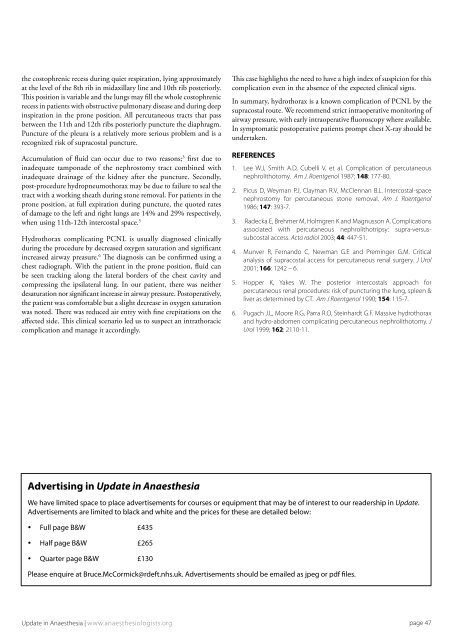Surgically placed rectus sheath catheters - The Global Regional ...
Surgically placed rectus sheath catheters - The Global Regional ...
Surgically placed rectus sheath catheters - The Global Regional ...
You also want an ePaper? Increase the reach of your titles
YUMPU automatically turns print PDFs into web optimized ePapers that Google loves.
the costophrenic recess during quiet respiration, lying approximately<br />
at the level of the 8th rib in midaxillary line and 10th rib posteriorly.<br />
This position is variable and the lungs may fill the whole costophrenic<br />
recess in patients with obstructive pulmonary disease and during deep<br />
inspiration in the prone position. All percutaneous tracts that pass<br />
between the 11th and 12th ribs posteriorly puncture the diaphragm.<br />
Puncture of the pleura is a relatively more serious problem and is a<br />
recognized risk of supracostal puncture.<br />
Accumulation of fluid can occur due to two reasons; 3 first due to<br />
inadequate tamponade of the nephrostomy tract combined with<br />
inadequate drainage of the kidney after the puncture. Secondly,<br />
post-procedure hydropneumothorax may be due to failure to seal the<br />
tract with a working <strong>sheath</strong> during stone removal. For patients in the<br />
prone position, at full expiration during puncture, the quoted rates<br />
of damage to the left and right lungs are 14% and 29% respectively,<br />
when using 11th-12th intercostal space. 5<br />
Hydrothorax complicating PCNL is usually diagnosed clinically<br />
during the procedure by decreased oxygen saturation and significant<br />
increased airway preasure. 6 <strong>The</strong> diagnosis can be confirmed using a<br />
chest radiograph. With the patient in the prone position, fluid can<br />
be seen tracking along the lateral borders of the chest cavity and<br />
compressing the ipsilateral lung. In our patient, there was neither<br />
desaturation nor significant increase in airway pressure. Postoperatively,<br />
the patient was comfortable but a slight decrease in oxygen saturation<br />
was noted. <strong>The</strong>re was reduced air entry with fine crepitations on the<br />
affected side. This clinical scenario led us to suspect an intrathoracic<br />
complication and manage it accordingly.<br />
This case highlights the need to have a high index of suspicion for this<br />
complication even in the absence of the expected clinical signs.<br />
In summary, hydrothorax is a known complication of PCNL by the<br />
supracostal route. We recommend strict intraoperative monitoring of<br />
airway pressure, with early intraoperative fluoroscopy where available.<br />
In symptomatic postoperative patients prompt chest X-ray should be<br />
undertaken.<br />
REFERENCES<br />
1. Lee W.J, Smith A.D, Cubelli V, et al. Complication of percutaneous<br />
nephrolithotomy. Am J. Roentgenol 1987; 148: 177-80.<br />
2. Picus D, Weyman P.J, Clayman R.V, McClennan B.L. Intercostal-space<br />
nephrostomy for percutaneous stone removal. Am J. Roentgenol<br />
1986; 147: 393-7.<br />
3. Radecka E, Brehmer M, Holmgren K and Magnusson A. Complications<br />
associated with percutaneous nephrolithotripsy: supra-versussubcostal<br />
access. Acta radiol 2003; 44: 447-51.<br />
4. Munver R, Fernando C, Newman G.E and Preminger G.M. Critical<br />
analysis of supracostal access for percutaneous renal surgery. J Urol<br />
2001; 166: 1242 – 6.<br />
5. Hopper K, Yakes W. <strong>The</strong> posterior intercostals approach for<br />
percutaneous renal procedures: risk of puncturing the lung, spleen &<br />
liver as determined by CT. Am J Roentgenol 1990; 154: 115-7.<br />
6. Pugach J.L, Moore R.G, Parra R.O, Steinhardt G.F. Massive hydrothorax<br />
and hydro-abdomen complicating percutaneous nephrolithotomy. J<br />
Urol 1999; 162: 2110-11.<br />
Advertising in Update in Anaesthesia<br />
We have limited space to place advertisements for courses or equipment that may be of interest to our readership in Update.<br />
Advertisements are limited to black and white and the prices for these are detailed below:<br />
• Full page B&W £435<br />
• Half page B&W £265<br />
• Quarter page B&W £130<br />
Please enquire at Bruce.McCormick@rdeft.nhs.uk. Advertisements should be emailed as jpeg or pdf files.<br />
Update in Anaesthesia | www.anaesthesiologists.org<br />
page 47
















